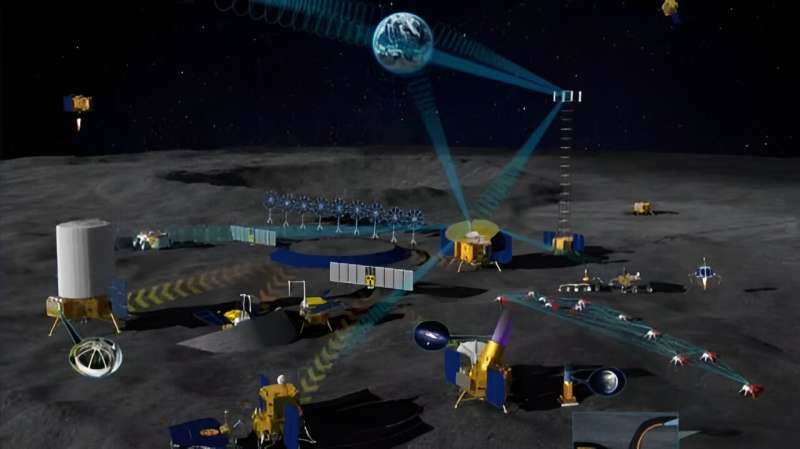This article has been reviewed according to Science X's editorial process and policies. Editors have highlighted the following attributes while ensuring the content's credibility:
fact-checked
trusted source
proofread
China proposes magnetic launch system for sending resources back to Earth

In his famous novel "The Moon is a Harsh Mistress," Robert A. Heinlein describes a future lunar settlement where future lunar residents ("Loonies") send payloads of wheat and water ice to Earth using an electromagnetic catapult.
In the story, a group of Loonies conspire to take control of this catapult and threaten to "throw rocks at Earth" unless they recognize Luna as an independent world. Interestingly enough, scientists have explored this concept for decades as a means of transferring lunar resources to Earth someday.
Given that space agencies are planning on sending missions to the moon to create permanent infrastructure, there is renewed interest in this concept. In a recent paper, a team of scientists from China's Shanghai Institute of Satellite Engineering (SAST) detailed how a magnetic launcher on the lunar surface could provide a cost-effective means of sending resources back to Earth.
This proposal could become part of China's long-term vision for a lunar settlement known as the International Lunar Research Station (ILRS)—a joint project they are pursuing with the Russian space agency (Roscosmos).
According to a recent article in the "South China Morning Post," the catapult would utilize magnetic levitation (maglev) technology and operate on the same principle as the hammer throw in athletics, "but rotating at increasing speeds before throwing the launch capsule towards Earth."
On the lunar surface, the near-vacuum environment and low gravity—roughly 16.5% of Earth's gravity (0.165 g)—would facilitate the ejection of payloads. According to the SAST team, the proposed system could conduct two launches a day at one-tenth the cost of existing transport methods.
As noted, the concept of a magnetic catapult on the moon is a time-honored idea. Previous versions of the concept include the Slingatron proposed in 1998 by noted physicist Derek A. Tidman, which called for a circular magnetic accelerator rather than a rotating arm.
Similarly, the launch system proposed by the Chinese research team would consist of a 50-meter (165 ft) rotating arm and a high-temperature superconducting motor. It would be powered by solar panels and a nuclear reactor and is designed to convert kinetic energy into electricity during the deceleration phase. This would allow it to recover more than 70% of the energy consumed after each launch.
After accelerating for 10 minutes, the arm would achieve the moon's escape velocity of 2.4 km/second (1.5 mps) and release the payload on a trajectory toward Earth. The team also emphasizes that the main payload would be helium-3 harvested from lunar soil, which could be used to power fusion reactors on Earth.
"The system's technical readiness is relatively high," they wrote. "Since it consumes only electricity and does not require any propellant, it will be relatively small in scale and straightforward to implement. The main goal is to extract and return helium-3 to help address Earth's energy crisis. The project will also boost the development of space mining technologies, heavy launch vehicles, and artificial intelligence."
While only 0.5 metric tons (0.55 U.S. tons) of this element can be found on Earth, an estimated 1 million metric tons (1.1 U.S. tons) are contained within the moon's regolith. According to the team's paper, 20 metric tons (22 U.S. tons) would be enough to meet China's annual electricity needs, whereas 1 million metric tons would be enough to meet the world's energy needs for more than a thousand years. They also estimate that the system will weigh about 80 metric tons (88 U.S. tons) and could remain in operation for at least 20 years.
However, construction of this system will have to wait until China has finished developing its Long March 9 (CZ-9) and Long March 10 (CZ-10) super-heavy launch vehicles. These rockets are vital to creating the ILRS, which is expected to be completed by 2035 with the help of other national space agencies.
In this respect, the proposed launch system could become a part of China's long-term plans for lunar development during the late 2030s or 2040s. The team's proposed timelines are consistent with this: they hope to complete the development of the system's key components by 2030 and anticipate full-scale implementation by 2045.
Naturally, as with all other proposals for lunar construction and development, there is the issue of cost. According to the research team, the cost of building the launch system would be an estimated 130 billion, equivalent to 18.25 billion USD.
However, at last year's meeting of the China Association for Science and Technology (CAST), team member Chu Yingzhi stated that mining three to five tons of helium-3 annually could bring in revenues of 100 billion yuan. There are also a lot of technical and logistical challenges that need to be addressed before this system can be constructed.
For starters, the research team's paper does not address how Helium-3 will be extracted from the local regolith. As Chu noted, there's also the challenge of installing it on the rugged lunar surface, ensuring the rotating arm remains stable at high speeds, and ensuring it can operate in the lunar environment, which is subject to extreme variations in temperature, cosmic rays, and increased levels of solar radiation.
But as a long-term vision, a magnetic launch system is an elegant proposal and a relatively cost-effective alternative to spacecraft launching from the surface.
Provided by Universe Today





















